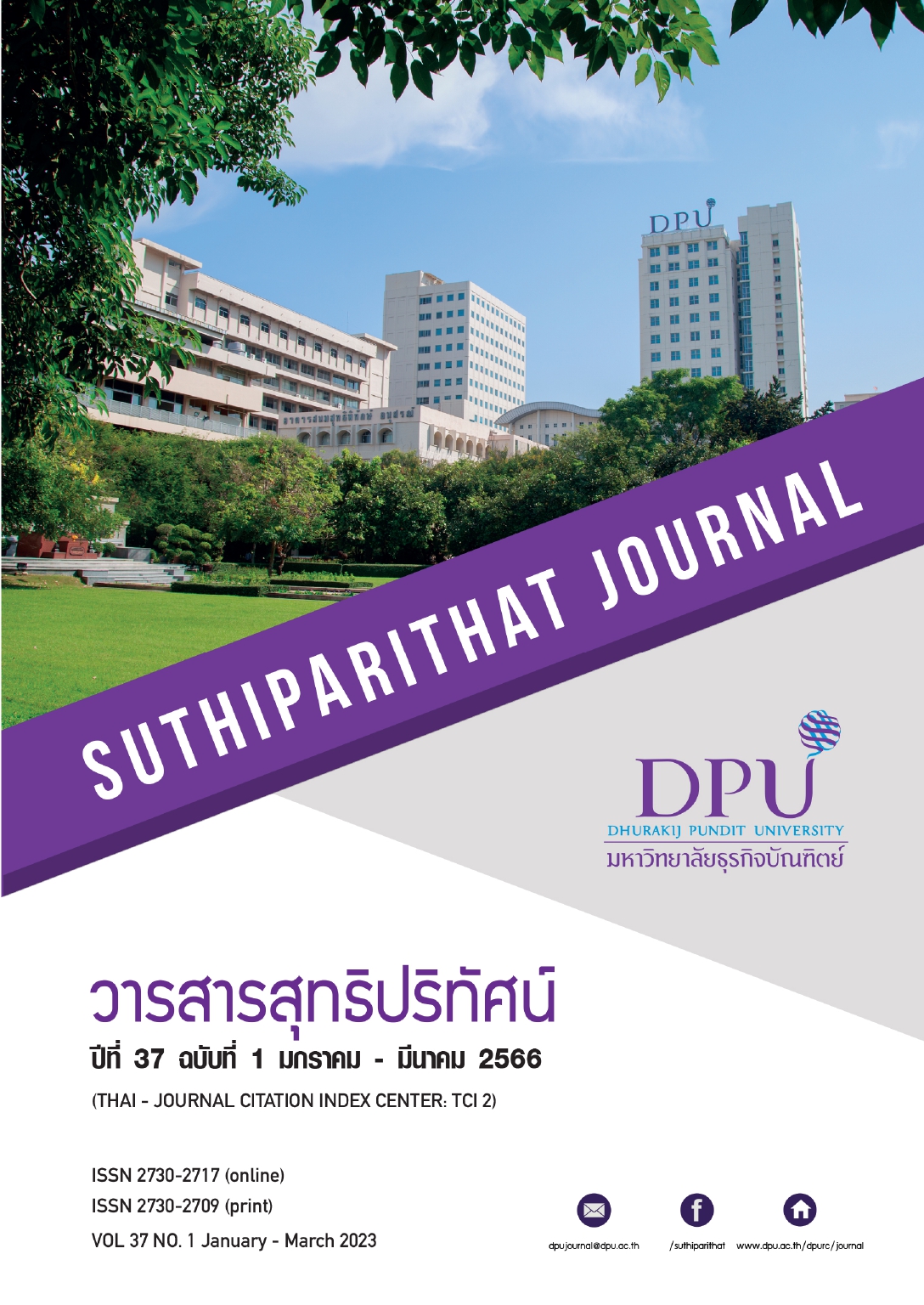อิทธิพลของสื่อดิจิทัลทางการตลาด การรับรู้คุณค่า และความชื่นชอบในตราสินค้าที่ส่งผลต่อการตัดสินใจเลือกศึกษาต่อในสถาบันอุดมศึกษาเอกชน
คำสำคัญ:
สื่อดิจิทัลทางการตลาด, การรับรู้คุณค่า, ความชื่นชอบในตราสินค้า, การตัดสินใจ, สถาบันอุดมศึกษาเอกชนบทคัดย่อ
การวิจัยครั้งนี้มีวัตถุประสงค์เพื่อศึกษา (1) พฤติกรรมการใช้สื่อดิจิทัลบนอินเทอร์เน็ตของนักเรียนในระดับชั้นมัธยมศึกษาตอนปลาย และ (2) อิทธิพลของสื่อดิจิทัลทางการการตลาด (บริการเครือข่ายสังคมออนไลน์และวิดีโอออนไลน์) การรับรู้คุณค่าและความชื่นชอบในตราสินค้าที่ส่งผลต่อการตัดสินใจเลือกศึกษาต่อในสถาบันอุดมศึกษาเอกชน การศึกษาครั้งนี้เป็นการวิจัยเชิงปริมาณ โดยใช้วิธีการสำรวจจากแบบสอบถามกับตัวอย่างที่เป็นนักเรียนในระดับชั้นมัธยมศึกษาตอนปลายหรือเทียบเท่า จำนวน 500 คน วิเคราะห์ข้อมูลด้วยค่าสถิติเชิงพรรณา เช่น ค่าร้อยละ ค่าเฉลี่ย ค่าเบี่ยงเบนมาตรฐาน และทดสอบสมมติฐานด้วยการวิเคราะห์ตัวแบบสมการโครงสร้าง
ผลการวิจัยพบว่าผู้ตอบแบบสอบถามส่วนใหญ่ใช้อินเทอร์เน็ตช่วง 18.01–24.00 น. จำนวน 4-6 ชั่วโมงต่อวัน ผ่านอุปกรณ์สมาร์ทโฟน โดยมีวัตถุประสงค์เพื่อเข้าถึงบริการเครือข่ายสังคมออนไลน์ออนไลน์และเปิดรับข่าวสารด้านบันเทิง สำหรับด้านการทดสอบสมมติฐานจากสมการเชิงโครงสร้างพบว่า สื่อดิจิทัลทางการตลาดมีอิทธิพลเชิงบวกต่อการรับรู้คุณค่าความเป็นสถาบันอุดมศึกษาเอกชน และความชื่นชอบในตราสินค้าสถาบันอุดมศึกษาเอกชน อีกทั้งการรับรู้คุณค่าความเป็นสถาบันอุดมศึกษาเอกชน และความชื่นชอบในตราสินค้าสถาบันอุดมศึกษามีอิทธิพลเชิงบวกต่อการตัดสินใจเลือกศึกษาต่อในสถาบันอุดมศึกษาเอกชนที่ระดับนัยสำคัญทางสถิติที่ระดับ 0.01
เอกสารอ้างอิง
กระทรวงการอุดมศึกษา วิทยาศาสตร์ วิจัยและนวัตกรรม. (2564ก, 23 กรกฎาคม). จำนวนสถาบันอุดมศึกษา จำแนกตามกลุ่มสถาบัน. ศูนย์กลางข้อมูลเปิด (MHESI Open Data). https://data.mhesi.go.th/dataset/univ_uni_11_06
กระทรวงการอุดมศึกษา วิทยาศาสตร์ วิจัยและนวัตกรรม. (2564ข, 22 กรกฎาคม). นักศึกษาเข้าใหม่ จำแนกตาม กลุ่มสถาบัน ชื่อสถาบัน คณะ สาขาวิชา ระดับการศึกษา และ เพศ. ศูนย์กลางข้อมูลเปิด (MHESI Open Data). https://data.mhesi.go.th/dataset/univ_std_11_04
ทรงพล สุ่นตระกูล. (2561). อิทธิพลของสื่อดิจิทัลทางการตลาดเพื่อการรับรู้คุณค่าความเป็นสถาบันการศึกษาและการเปลี่ยนแปลงทัศนคติที่ส่งผลต่อการตัดสินใจเข้าศึกษาระดับบัณฑิตศึกษาที่มหาวิทยาลัยเอกชน [วิทยานิพนธ์ปริญญามหาบัณฑิต, มหาวิทยาลัยกรุงเทพ]. DSpace at Bangkok University. http://dspace.bu.ac.th/jspui/handle/123456789/3564
ปาลิตา จงจิต. (2562). ภาพลักษณ์ตราสินค้าของมหาวิทยาลัย ความคาดหวังของนักเรียน ส่งผลต่อการมีส่วนร่วมของนักเรียน ความชื่นชอบในตราสินค้าของมหาวิทยาลัย และการตัดสินใจเข้าศึกษาต่อในมหาวิทยาลัยเอกชนที่ใช้การสอนด้วยระบบไฮบริดของนักเรียนมัธยมศึกษา ชั้นปีที่ 6 ใน เขตพื้นที่การศึกษากรุงเทพมหานคร [วิทยานิพนธ์ปริญญามหาบัณฑิต, มหาวิทยาลัยกรุงเทพ]. DSpace at Bangkok University. http://dspace.bu.ac.th/jspui/handle/123456789/4419
ปิ่นปินัทธ์ จ่าดา, และ ชลทิศ ดาราวงษ์. (2562). อิทธิพลของสื่อดิจิทัลที่มีผลต่อความเชื่อมั่น การบอกต่อ ความชอบ และการจดจําแบรนด์ของมหาวิทยาลัยเอกชนแห่งหนึ่งในจังหวัดชลบุรี. วารสารวิชาการ สถาบันวิทยาการจัดการแห่งแปซิฟิค, 6(1), 263-272. https://so05.tci-thaijo.org/index.php/pacific/article/view/225005/165274
ภัทรวดี เหรียญมณี. (2558). การสื่อสารทางการตลาดแบบบูรณาการผ่านสื่อดิจิทัลที่ส่งผลต่อการตัดสินใจใช้บริการค่ายมวย (Boxing Gym) เพื่อการออกกำลังกายในเขตกรุงเทพมหานคร [การค้นคว้าอิสระปริญญามหาบัณฑิต, มหาวิทยาลัยกรุงเทพ]. DSpace at Bangkok University. http://dspace.bu.ac.th/jspui/handle/123456789/2114
รัฐพงศ์ บุญญานุวัตร. (2559, 9 กันยายน). มหาวิทยาลัย ศักดิ์ศรีและความเท่าเทียม. มติชนออนไลน์. https://www.matichon.co.th/columnists/news_278750
รัฐพงศ์ บุญญานุวัตร. (2561, 2 มกราคม). ทางรอด..ทางเลือก สถาบันอุดมศึกษาเอกชน. มติชนออนไลน์. https://www.matichon.co.th/education/news_787866
ศรุดา ชัยสุวรรณ, กฤษฎา วัฒนศักดิ์, และ จักรี บูรณวงศ์สวัสดิ์. (2563). ความอยู่รอดปลอดภัยในภาวะชะลอตัวของมหาวิทยาลัยเอกชนไทย. วารสารวิชาการสถาบันเทคโนโลยีแห่งสุวรรณภูมิ, 6(1), 611-622. https://so04.tci-thaijo.org/index.php/svittj/article/view/241256/165866
สำนักงานพัฒนาธุรกรรมทางอิเล็กทรอนิกส์. (2564, 15 ธันวาคม). ETDA เผยโควิด-19 เป็นเหตุสังเกตได้ Gen Z ใช้เน็ตสูงสุด ปีแรก ชนะ Gen Y แชมป์ 6 สมัย. https://www.etda.or.th/th/pr-news/ETDA-released-IUB-2021.aspx
อิศราภรณ์ ขวัญใจ. (2562). ปัจจัยที่มีอิทธิพลต่อทัศนคติและแนวโน้มการศึกษาต่อมหาวิทยาลัยเอกชนขนาดใหญ่ในกรุงเทพมหานครและปริมณฑลของนักศึกษาปริญญาตรี [สารนิพนธ์ปริญญามหาบัณฑิต, มหาวิทยาลัยศรีนครินทรวิโรฒ]. DSpace at Srinakharinwirot University. http://ir-ithesis.swu.ac.th/dspace/handle/123456789/543
Aaker, D. A. (1992). Managing brand equity: Capitalizing on the value of a brand name. The Free Press.
Bovee, C. L., Michael, J. H., & John, V. T. (1995). Marketing (2nd ed.). McGrew Hill.
Chi, T., & Kilduff, P. P. (2011). Understanding consumer perceived value of casual sportswear: An empirical study. Journal of Retailing and Consumer Services, 18(5), 422-429. https://doi.org/10.1016/j.jretconser.2011.06.004
Comrey, A. (1973). A first course on factor analysis. Academic Press.
Cortina, J. M. (1993). What is coefficient alpha: An examination of theory and applications. Journal of Applied Psychology, 78(1), 98-104. https://doi.org/10.1037/0021-9010.78.1.98
Ebrahim, R. S. (2013). A study of brand preference: An experiential view [Doctoral dissertation, Brunel university]. Brunel University Research Archive. https://bura.brunel.ac.uk/bitstream/2438/7542/1/FulltextThesis.pdf
Hair, J. F., Hult, G. T. M., Ringle, C. M., & Sarstedt, M. (2017). A Primer on Partial Least Squares Structural Equation Modeling (PLS-SEM) (2nd ed.). Sage.
Hair, J. F., Sarstedt, M., Hopkins, L., & Kuppelwieser, V. G. (2014). Partial Least Squares Structural Equation Modeling (PLS-SEM): An emerging tool in business research. European Business Review, 26(2), 106-121. https://doi.org/10.1108/EBR-10-2013-0128
Hawkins, I. D., & Mothersbaugh, L. D. (2013). Consumer behavior building marketing strategy (12th ed.). McGraw-hill/Irwin.
Kotler, P., & Keller, K. L. (2012). Marketing management (14th ed.). Prentice-Hall.
Schumacher, R. E., & Lomax, R. G. (2010). A beginner guide to structural equation modeling: SEM. Lawrence Erlbaum Associates.
Sekaran, U. (2003). Research methods for business: A skill-building approach (4th ed.). John Wiley & Sons.
Zajonc, R. B., & Markus, H. (1982). Affective and cognitive factors in preferences. Journal of Consumer Research, 9(2), 123-131. http://www.jstor.org/stable/2489121.
ดาวน์โหลด
เผยแพร่แล้ว
รูปแบบการอ้างอิง
ฉบับ
ประเภทบทความ
สัญญาอนุญาต
ลิขสิทธิ์ (c) 2023 มหาวิทยาลัยธุรกิจบัณฑิตย์

อนุญาตภายใต้เงื่อนไข Creative Commons Attribution-NonCommercial-NoDerivatives 4.0 International License.
เนื้อหาและข้อมูลในบทความที่ลงตีพิมพ์ในวารสารสุทธิปริทัศน์ ถือเป็นข้อคิดเห็นและความรับผิดชอบของผู้เขียนบทความโดยตรงซึ่งกองบรรณาธิการวารสาร ไม่จำเป็นต้องเห็นด้วย หรือร่วมรับผิดชอบใด ๆ
บทความ ข้อมูล เนื้อหา รูปภาพ ฯลฯ ที่ได้รับการตีพิมพ์ในวารสารสุทธิปริทัศน์ ถือเป็นลิขสิทธิ์ของวารสารสุทธิปริทัศน์หากบุคคลหรือหน่วยงานใดต้องการนำทั้งหมดหรือส่วนหนึ่งส่วนใดไปเผยแพร่ต่อหรือเพื่อกระทำการใด ๆ จะต้องได้รับอนุญาตเป็นลายลักษณ์อักษรจากวารสารสุทธิปริทัศน์ก่อนเท่านั้น







